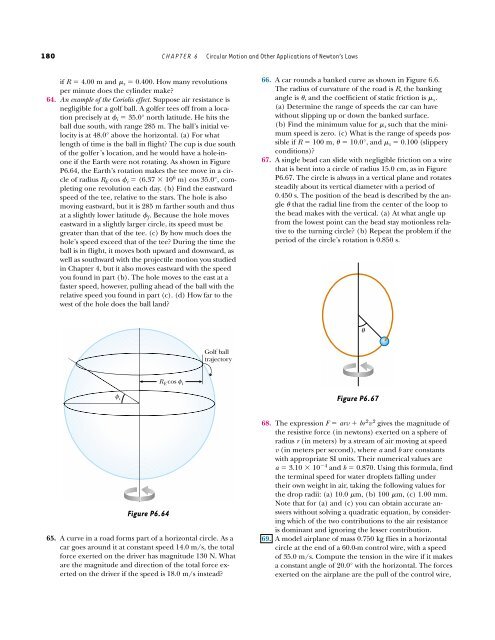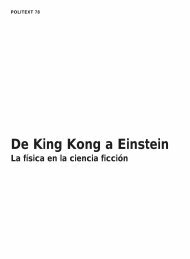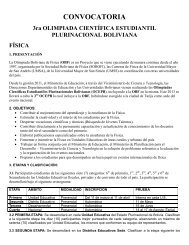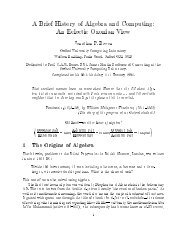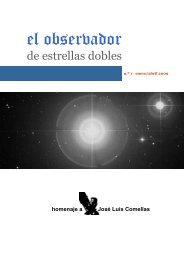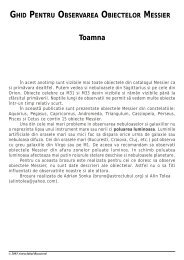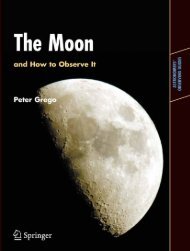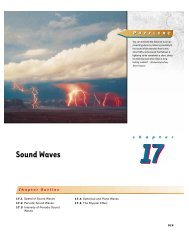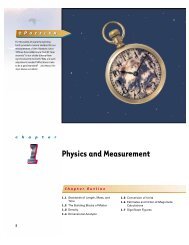Circular Motion and Other Applications of Newton's Laws
Circular Motion and Other Applications of Newton's Laws
Circular Motion and Other Applications of Newton's Laws
You also want an ePaper? Increase the reach of your titles
YUMPU automatically turns print PDFs into web optimized ePapers that Google loves.
180 CHAPTER 6 <strong>Circular</strong> <strong>Motion</strong> <strong>and</strong> <strong>Other</strong> <strong>Applications</strong> <strong>of</strong> Newton’s <strong>Laws</strong><br />
if R � 4.00 m <strong>and</strong> � s � 0.400. How many revolutions<br />
per minute does the cylinder make?<br />
64. An example <strong>of</strong> the Coriolis effect. Suppose air resistance is<br />
negligible for a golf ball. A golfer tees <strong>of</strong>f from a location<br />
precisely at � i � 35.0° north latitude. He hits the<br />
ball due south, with range 285 m. The ball’s initial velocity<br />
is at 48.0° above the horizontal. (a) For what<br />
length <strong>of</strong> time is the ball in flight? The cup is due south<br />
<strong>of</strong> the golfer’s location, <strong>and</strong> he would have a hole-inone<br />
if the Earth were not rotating. As shown in Figure<br />
P6.64, the Earth’s rotation makes the tee move in a circle<br />
<strong>of</strong> radius R E cos � i � (6.37 � 10 6 m) cos 35.0°, completing<br />
one revolution each day. (b) Find the eastward<br />
speed <strong>of</strong> the tee, relative to the stars. The hole is also<br />
moving eastward, but it is 285 m farther south <strong>and</strong> thus<br />
at a slightly lower latitude � f. Because the hole moves<br />
eastward in a slightly larger circle, its speed must be<br />
greater than that <strong>of</strong> the tee. (c) By how much does the<br />
hole’s speed exceed that <strong>of</strong> the tee? During the time the<br />
ball is in flight, it moves both upward <strong>and</strong> downward, as<br />
well as southward with the projectile motion you studied<br />
in Chapter 4, but it also moves eastward with the speed<br />
you found in part (b). The hole moves to the east at a<br />
faster speed, however, pulling ahead <strong>of</strong> the ball with the<br />
relative speed you found in part (c). (d) How far to the<br />
west <strong>of</strong> the hole does the ball l<strong>and</strong>?<br />
φ i<br />
Figure P6.64<br />
R E cos φ i<br />
Golf ball<br />
trajectory<br />
65. A curve in a road forms part <strong>of</strong> a horizontal circle. As a<br />
car goes around it at constant speed 14.0 m/s, the total<br />
force exerted on the driver has magnitude 130 N. What<br />
are the magnitude <strong>and</strong> direction <strong>of</strong> the total force exerted<br />
on the driver if the speed is 18.0 m/s instead?<br />
66. A car rounds a banked curve as shown in Figure 6.6.<br />
The radius <strong>of</strong> curvature <strong>of</strong> the road is R, the banking<br />
angle is �, <strong>and</strong> the coefficient <strong>of</strong> static friction is � s.<br />
(a) Determine the range <strong>of</strong> speeds the car can have<br />
without slipping up or down the banked surface.<br />
(b) Find the minimum value for � s such that the minimum<br />
speed is zero. (c) What is the range <strong>of</strong> speeds possible<br />
if R � 100 m, � � 10.0°, <strong>and</strong> � s � 0.100 (slippery<br />
conditions)?<br />
67. A single bead can slide with negligible friction on a wire<br />
that is bent into a circle <strong>of</strong> radius 15.0 cm, as in Figure<br />
P6.67. The circle is always in a vertical plane <strong>and</strong> rotates<br />
steadily about its vertical diameter with a period <strong>of</strong><br />
0.450 s. The position <strong>of</strong> the bead is described by the angle<br />
� that the radial line from the center <strong>of</strong> the loop to<br />
the bead makes with the vertical. (a) At what angle up<br />
from the lowest point can the bead stay motionless relative<br />
to the turning circle? (b) Repeat the problem if the<br />
period <strong>of</strong> the circle’s rotation is 0.850 s.<br />
θ<br />
Figure P6.67<br />
68. The expression F � arv � br 2 v 2 gives the magnitude <strong>of</strong><br />
the resistive force (in newtons) exerted on a sphere <strong>of</strong><br />
radius r (in meters) by a stream <strong>of</strong> air moving at speed<br />
v (in meters per second), where a <strong>and</strong> b are constants<br />
with appropriate SI units. Their numerical values are<br />
a � 3.10 � 10 �4 <strong>and</strong> b � 0.870. Using this formula, find<br />
the terminal speed for water droplets falling under<br />
their own weight in air, taking the following values for<br />
the drop radii: (a) 10.0 �m, (b) 100 �m, (c) 1.00 mm.<br />
Note that for (a) <strong>and</strong> (c) you can obtain accurate answers<br />
without solving a quadratic equation, by considering<br />
which <strong>of</strong> the two contributions to the air resistance<br />
is dominant <strong>and</strong> ignoring the lesser contribution.<br />
69. A model airplane <strong>of</strong> mass 0.750 kg flies in a horizontal<br />
circle at the end <strong>of</strong> a 60.0-m control wire, with a speed<br />
<strong>of</strong> 35.0 m/s. Compute the tension in the wire if it makes<br />
a constant angle <strong>of</strong> 20.0° with the horizontal. The forces<br />
exerted on the airplane are the pull <strong>of</strong> the control wire,


